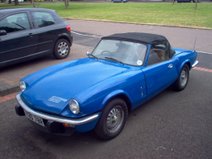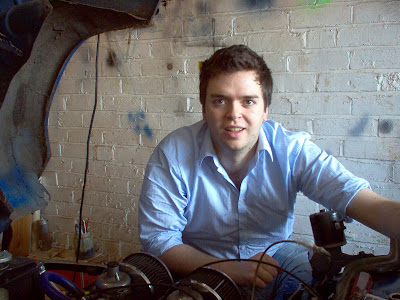Obviously, being new to MIG welding, I had to invest in the appropriate safety gear. There's a really good forum attached to the Mig welding website and virtually everyone on it recommended the auto dimming type of mask. I picked up a 'SIF Lite' mask off eBay for a very reasonable £45. This dims automatically when you look at bright light and should be just the job! In terms of clothing, I picked up a 'Silverline' apron (£6.89) on eBay and a pair of ESAB MIG gauntlets (£7.85) from the Weldequip shop.
My shopping list would have stopped there - but one of the guys on the Sideways Forum mentioned the importance of having a fire extinguisher. This got me thinking! Obviously, I've always had a workshop fire extinguisher but had I ever really looked at it properly? tested it? did I even know how to use it!? I took a good look at it and a few things began to worry me. Firstly, I couldn't even begin to guess at how old it was! It actually had the MOD 'arrow' mark on it which means it was most likely obtained by my dad when he still lived in London. That would've been in the '70's! Secondly, it didn't have a pressure gauge so I couldn't tell how full it was. Obviously this was no good, so with the knowledge that I'd be replacing it anyway, I decided to see if it worked. Worryingly, but not unsuprisingly, it didn't work at all.
So, with a decent CO2 fire extinguisher on the shopping list, my thoughts turned to my other workshop safety gear. I've actually been pretty good with safety gear in so much as I've got it and I use it, but was the stuff I had any good?
In terms of eye protection, I've always used a pair of safety glasses for general work and a pair of goggles for grinding. The glasses came free with a garden strimmer about 15 years ago and the goggles were part of a £5 'safety kit' that I got when I hired a floor sander from HSS! Both would probably have worked but neither had any kind of safety markings (CE mark etc) and the goggles were horrifically uncomfortable so both went on my shopping list. Amazingly, protective eyewear is really cheap, so there was no excuse for me not to get some! I picked up a pair of Bolle 'Spider' glasses (good for impacts up to 45m/s and CE marked) for £5.45 (eBay) and a pair of Bolle 'Blast' goggles (120m/s impact protection and CE marked) for £5.99 (also from eBay).
For ear protection, I've always just used cheap disposable foam earplugs. Now I'm doing grinding on an almost industrial scale, I thought it was about time I got something a bit better, so I invested in a pair of Peltor 'Optime 1' ear defenders. These are good for general workshop use and cost just £8 from eBay. I have actually used the military spec versions of these whilst shooting in the past so I can vouch for their effectiveness!

While I was in the mood I also picked up some more gloves. OMP do a good pair of general rubberised workshop gloves for £2 (eBay) so I had a couple of pairs of those to go with the fibreglass pair I already had.
So there we go, safety equipment might not be the most exciting or fun thing in the world, but it's good to know that for less than £25, you can get good quality, stylish and up to date eye, ear and hand protection. Done!











































 Basically, instead of going direct to the lights the wires from the switchgear go to a relay instead. When the light switch is pressed the relay circuit activates the secondary circuit which connects the lights directly to the battery. So that's the theory! You also need to do a bit of maths to make sure the cable can support the current it needs to be carrying. All you really need to know is Power = Current x Voltage. Most headlamp bulbs are 55/60 Watt so the current will be around 5 amps. Because there are 2 headlamps we need cable and relays that can take at least 10 amps. I decided to go a bit bigger on the battery supply cable to give me more capacity for upgrades in the future. The relays required are the common as muck 30A type.
Basically, instead of going direct to the lights the wires from the switchgear go to a relay instead. When the light switch is pressed the relay circuit activates the secondary circuit which connects the lights directly to the battery. So that's the theory! You also need to do a bit of maths to make sure the cable can support the current it needs to be carrying. All you really need to know is Power = Current x Voltage. Most headlamp bulbs are 55/60 Watt so the current will be around 5 amps. Because there are 2 headlamps we need cable and relays that can take at least 10 amps. I decided to go a bit bigger on the battery supply cable to give me more capacity for upgrades in the future. The relays required are the common as muck 30A type.








